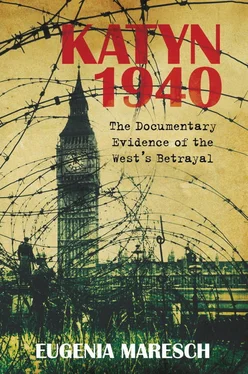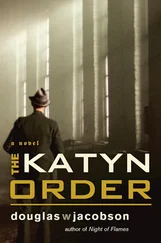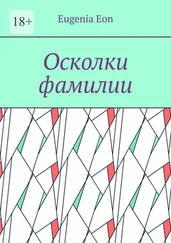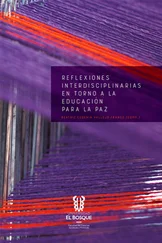Janusz Laskowski, born in 1908 near Smolensk, knew Katyn woods well, where he often cycled as a boy. A journalist of Socialist convictions, editor of pre-war Iskra (A spark) and Kurier Wileński (Wilno’s Courier), released from Russia with the Polish Army in 1942. War correspondent and one of the editors of clandestine Radio Unit Świt (Dawn) engaged in black propaganda broadcasts 1943–44. In 1946 sent to Nuremberg to report on the Katyn trial. He was also instrumental in tracking down Herr Germandt in Germany, who in 1941 was posted to Katyn. Germandt’s interview is recorded later.
Albert Frederick Pollard (1869–1948) constitutional historian at the University of London 1903, served on the Government Committee on the League of Nations, visiting Professor in Canada and USA, founder and Director of the Institute of Historical Research until 1939, contributed to the Dictionary of National Biography, wrote articles on parliamentary history for the English Historical Review.
James Headlam-Morley (1863–1929), historical adviser to the propaganda department in 1917 and the FO until 1928. Took part in negotiations at the Paris Peace Conference, (Treaty of Versailles), 28 June 1919.
John G. Winant, American Ambassador in London.
TNA FO 688/31/9 enclosure I in O’Malley’s despatch No. 51 of May 24 1943.The list contains 49 names and rank of missing officers, as well as names of relatives in the UK.
TNA FO 371/34577/ C6161 C6160/258/55 Secure Signal 1943 May 15, from the underground organisation in Warsaw. Unauthorised copy obtained by O’Malley from his ‘contacts’ without prior knowledge of the Polish government-in-exile and asked by O’Malley to be treated as ‘particularly secret’; SPP Studium Polski Podziemnej (Polish Underground Movement Trust) in London, ref. A.7.1.1.The original signal in Polish L.dz. 2290/tjn 43, Radiogram No. 779, Wanda 6, 13 5 43, deciphered 14 5 43 1030, despatched by ‘Kalina’ (Gen. Stefan Rowecki, head of AK) indicating the source of information as Dr Adam Schebesta of the PCK. In point 7 of the report, a sentence was intentionally omitted in translation by Lt Col Protasewicz, head of Oddział VI (the VI Bureau), before being passed onto O’Malley; as indicated, it should have read ‘All bullets are of 7.65 calibre, shells bear inscription Geco, the ropes are of twisted variety’.
TNA FO 371/34577 C.6160/258/55 refers to the report from Ambassador O’Malley about the disappearance of the Polish officers. Contains remarks and comments by FO officials including Sir Alexander Cadogan.
The Diaries of Sir Alexander Cadogan O.M.1938 - 1945 , edited by David Dilks, Cassell 1971, pp 520-528.
TNA CAB 65/34 Minutes of the War Cabinet 59 meeting 27 April 194; on the agenda Russo-Polish Relations; present at the meeting: W. Churchill PM, C. Attlee Secretary of State for Dominions, A. Eden Secretary of State for Foreign Affairs, E. Bevin, Minister of Labour and National Service, Sir Alexander Cadogan, Permanent Under-Secretary of State for Foreign Affairs, the three Chiefs of Staff, and many others.
Tehran Conference December 1943. The United States and Great Britain agreed with the USSR that the Polish boundary should go as far as the river Oder and the eastern boundary to run according to the Curzon Line. Stalin got his way with Eden and Churchill, who declared that ‘Russia had to have security in the west.’
Michał Sokolnicki Dziennik Ankarski 1939–1943 (Ankara Diary 1939–1943) London 1965, pp 503–547. Photograph of Madame Sokolnicka, Robin Hankey and Geoffrey Shaw originates from the book.
TNA GFM 33/403 No 262328 German Foreign Ministry Inland II g Collection entitled ‘ Geheime Reichssachen ’ 1944 Vol. XV (box 3) dated 9 January 1944.
TNA HW 12/288 ‘Most Secret’ German secure signal 117825,1943 May 22, transmitted via machine encryption, deciphered and translated by GCHQ and distributed in nine copies, entitled ‘Russo-Polish Dispute – German Version’ by the analysts at Berkeley St London. It was intercepted on 15 May 1943; GFM 33/2525, E 424331–2, shows original German text, nr Multex 459 dated 15th May 1943, sender Geheim Schrieber on Berlin to Berne link and signed by the Permanent Under Secretary Steengracht.
TNA HS 4/137 ‘Katyn and After’, typescript carbon copy of a memorandum dated 21 April 1943, sent to L/S (Political Liaison Section, cryptic designation for GSOII) to Major T. G. Roche RA, Intelligence Division of SOE by ‘MPX’ (Major Richard Truszkowski 1897-1988), an SOE desk officer GSO II, who got to know the Russians during a previous posting to Russia. Truszkowski was born in the UK of Polish parents who were political exiles. Studied Chemistry, first in England then in Poland. During WW I served in France and then with the North Russia Expeditionary Force. At the outbreak of WW 2, joined the British Military Mission in Warsaw. Served again in Russia, France and Middle East. Awarded Krzyż Walecznych, the Polish Cross of Valour in 1943. The file also contains a comprehensive report entitled ‘German Propaganda’, edited by the Polish Ministry of Internal Affairs in London, which attracted more attention from the Secret Intelligence Service (SIS), than the memorandum.
1 PISM KOL 12/16/d L.dz. 518/43 secure signals from the AK (Home Army) dated 19 IV 1943 give a list of names of people who were taken to Katyn to visit the graves: Goetel, Skiwski, Seyfried, Orzechowski, Grodzki, Prochownik, Kawecki, Didur. Second group: Rev. Jasiński, Schebesta, Pragłowski, Plappert, Martens, Skarżynski, Rojkiewicz, Wodzinowski, Bartoszewski, Kołodziejski, Dmochowski, Banach; TNA FO 371/34552 C4842, L.dz. 1960/43 original and translated AK signal signed by Lt Col Michał Protasewicz, Chief of Oddział VI , dated 26 IV 1943, annotated by WS (William Strang) ‘given to S of S by General Sikorski 28/4/43’; SPP Studium Polski Podziemnej (The Polish Underground Movement Study Trust) A 7.1.1. Ref L.dz. 2290 dated 15 May 1943, a signal in Polish from ‘Kalina’ [Gen. Rowecki] for Gen. Sikorski, information among other things about the 7.65 mm bullets made by GECO and twisted ropes; PISM KOL 12/16d L.dz. 2475/tjn.43, dated 27 V 1943 gives comprehensive information about the graves as seen by the first group of the PCK committee including Skarżyński’s report in French to the International Red Cross Committee in Geneva.
IWM (Imperial War Museum) FO 645/289 German archives captured by US in 1945 No.A084591, USSR-507/PS-402 held at Duxford, Teletype nr. 6 of 3 May 1943 17 20 Warsaw, from Heinrich to Weirauch in Kraków.
TNA HS 4/137 and FO 371/34582 C 7677/258/55G ref SK/AK/912 carbon copy of a letter 30 June 1943, from cryptic designation SD [Pay Lt Commander Ralph C. Hollingsworth RNVR] to MPX [Richard Truszkowski] SOE Polish Section, enclosing translated report by Dr Tramsen, Danish forensic expert, who visited the graves at Katyn.
TNA FO 371/56476 N5269G typed copies of the report in Polish, translation by EM: also at PISM KOL 12/4/9; official statement by Kazimierz Skarżyński (1887–1962) a successful industrialist, educated in Vienna, Paris and Trade Institute in Antwerp, spoke seven languages. Worked for a French firm, mining copper in the Caucasus. With political unrest, acted as a liaison between the Tartars and the Kurds. In 1919 on the intervention of the British Army (note Colonel Hulls’ presence), decided to return to Poland and join the newly formed Polish army. Fought the Bolsheviks in 1920 War of Independence. In between the wars worked for a French paper firm. In 1939 finding himself without work, offered his services to the Polish Red Cross, which was duly accepted and was given the post of General Secretary. Visited Katyn burial site, wrote two reports. Fearing for his life left Poland with wife and two children in May 1946. Stopped in Nuremberg during the trials on his way to Paris. After a short stay in England, immigrated to Canada. Employed in real estate and the old Credit Froncier, this time in Calgary. Took part in Congressional Hearings in Washington in 1952. A mainstay of Polish community in Calgary.
Читать дальше












